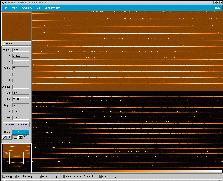Science Modes
Simultaneous Thorium Reference Method
This observing mode is the standard mode of HARPS. It is supported by the data reduction pipeline and therefore delivers the most accurate radial velocities (RV).
A Thorium-Argon lamp located in a separate calibration unit delivers light via a fibre link to the telescope focus. This light is sent by a small mirror into one of the two fibres which connect the telescope focus with the entrance of the spectrograph. The other fibre leads the star light to the spectrograph. Both spectra (star and Th-Ar) are recorded simultaneously by the CCD in one exposure. This procedure ensures the highest possible fidelity in the relative positions of both spectra.
A concise description of this method is given in "ELODIE: A spectrograph for accurate radial velocity measurements" by Baranne, Queloz, Mayor et al, A&ASup 119,373(1996)
 |
A simultaneous Thorium-Argon spectrum ("white dots") alongside the object spectrum. This is the HARPS First Light spectrum, recorded on February 11, 2003. |
Iodine Self-calibration Method (de-commissioned)
HARPS offers the use of an iodine cell which is located in the fibre adapter at the Cassegrain focus. The absorption lines of the Iodine vapour in the cell are imprinted on the stellar spectrum which is led by one fibre to the spectrograph.
The accuracy in the determination of radial velocities of this method are comparable to the Simultaneous Thorium Reference Method. However, the efficiency of the Iodine method is lower due to the absorption of the iodine cell. The determination of RV using the iodine self-calibration method with HARPS is not supported by the pipeline.
The FTS scans of cell # 3, which was used until May 2004 (when it broke), is available via ftp from the ESO server.
An internal memorandum is available describing the properties of three (Cassegrain fibre adapter, calibration unit, spare) of the HARPS iodine cells.
A concise description of this method is given by Endl M., Kuerster M., Els S., 2000, A&A, 362, 585 also available here
Classical Fibre Spectroscopy
HARPS can also be used as a ``normal'' spectrograph for classical fibre spectroscopy. In this mode one or two fibres are used: one for the star, the other one may be used for the sky, or not at all. In case it is used, one has to take care that no faint stars contaminate the sky measurement.
Calibrations
Apart from the wavelength calibrations, the following detector calibrations are regularly performed:
- flatfields: before the beginning of the night
- darks: once a week
- bias: determined from overscan
Details are described in the Calibration Plan.
